Building a Resilient Philly ADVICE
FOR THE NEXT MAYOR

SPRING 2023
MAYOR 2023 THE ELECTION FOR

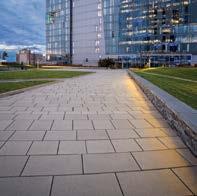











www.hanoverpavers.com • 800.426.4242 Custom aggregate blending has become Hanover’s trademark, as well as the ability to adapt to the special paver needs of each individual project. With a library of over 3,800 granite-like colors and a variety of finishes to choose from, the combinations are endless. Challenge uslet’s create a unique color for your next project. HANOVER® PREST® PAVERS CHESAPEAKE COLLECTION 3,800 CUSTOM COLORS AND COUNTING TERRAZZO COLLECTION GRANITE COLLECTION




AIA Philadelphia | context | SPRING 2023 1 FEATURES 14 An Open Letter to the Next Mayor of Philadelphia by Jeff Goldstein 16 Four Values Form a Base for Equitable Development in Kensington and Beyond by Dr. Bill McKinney 18 A Climate Justice Agenda for the Next Mayor by Christine Knapp 21 Supporting the “Civic” in Design Review by Nancy Rogo Trainer 23 Preservation Prescriptions for a Prosperous Philadelphia by Paul Steinke + Patrick Grossi 26 Developing a Predictable Housing Policy for Philadelphia by Mo Rushdy
Tell us what you think about the latest issue of CONTEXT magazine by emailing context@aiaphila.org. A member of the CONTEXT editorial committee will be sure to get back to you. SPRING 2023 IN THIS ISSUE , Local experts in the built environment share their wisdom and advice with Philadelphia’s next mayor.
EDITORS’ LETTER 10 COMMUNITY 28 DESIGN PROFILES ON THE COVER CONTEXT is
by
Postmaster:
of
to AIA Philadelphia,
Street,
PA 19107
MARCH 2023 Building a Resilient Philly ADVICE FOR THE NEXT MAYOR MAYOR 2023 26 23 18 16
Suggestions? Comments? Questions?
DEPARTMENTS 7
published
A Chapter of the American Institute of Architects 1218 Arch Street, Philadelphia, PA 19107 215-569-3186, www.aiaphiladelphia.com. The opinions expressed in this — or the representations made by advertisers, including copyrights and warranties, are not those of the editorial staff, publisher, AIA Philadelphia, or AIA Philadelphia’s Board of Directors. All rights reserved. Reproduction in part or whole without written permission is strictly prohibited.
send change
address
1218 Arch
Philadelphia,
Published
2023 BOARD OF DIRECTORS
Rob Fleming, AIA, LEED AP BD+C, President
Brian Smiley, AIA, CDT, LEED BD+C, President-Elect
Robert Shuman, AIA, LEED AP, Treasurer
Jeff Goldstein, AIA, Past President
Fátima Olivieri - Martínez, AIA, Secretary
David Hincher, Director of Sustainability + Preservation
Phil Burkett, AIA, WELL AP, LEED AP NCARB, Director of Firm Culture + Prosperity
Erick Oskey, AIA, Director of Technology + Innovation
Tya Winn, NOMA, LEED Green Associate, SEED, Director of Equity, Diversity + Inclusion and Public Member
Ximena Valle, AIA, LEED AP, Director of Design
Kevin Malawski, AIA, LEED AP, Director of Advocacy
Fauzia Sadiq Garcia, Director of Education
Timothy A. Kerner, AIA, LEED AP, Director of Professional Development
Danielle DiLeo Kim, AIA, Director of Strategic Engagement
Michael Johns, FAIA, NOMA, LEED AP, Director of Equitable Communities
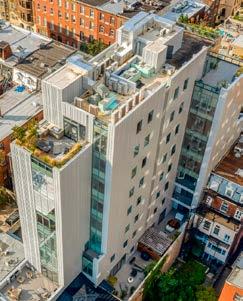
Clarissa Kelsey, AIA, At-Large Director
Sophia Lee, AIA, CPHC, LEED AP BD+C, WELL AP, At-Large Director
Scott Compton, AIA, NCARB, LEED AP, AIA PA Representative
Mike Penzel, Assoc. AIA, Director of Philadelphia Emerging Architects
Luka Lakuriqi, Assoc AIA, SEED, Director of Philadelphia Emerging Architects
Kenneth Johnson, Esq., MCP, AIA, NOMA, PhilaNOMA Representative
Rebecca Johnson, Executive Director
CONTEXT EDITORIAL BOARD
CO-CHAIRS
Harris M. Steinberg, FAIA, Drexel University
Todd Woodward, AIA, SMP Architects
BOARD MEMBERS
David Brownlee, Ph.D., FSAH, University of Pennsylvania
Julie Bush, ASLA, Ground Reconsidered
Daryn Edwards, AIA, CICADA Architecture Planning
Clifton Fordham, RA, Temple University
Fauzia Sadiq Garcia, RA, Temple University
Timothy Kerner, AIA, Terra Studio
Milton Lau, AIA, BLT Architects
Jeff Pastva, AIA Scannapieco Development Corporation
Eli Storch, AIA, LRK
Franca Trubiano, PhD, University of Pennsylvania
David Zaiser, AIA, HDR STAFF
Rebecca Johnson, AIA Philadelphia Executive Director
Elizabeth Paul, Managing Editor
Jody Canford, Advertising Manager, jody@aiaphila.org
Anne Bigler, annebiglerdesign.com, Design Consultant
Laurie Churchman, Designlore, Art Director

2 SPRING 2023 | context | AIA Philadelphia
ARCH RESOURCES, LLC. Peter Martindell, CSI Architectural Representative 29 Mainland Rd • Harleysville, PA 19438 Phone: 267-500-2142 Fax: 215-256-6591 peter@archres-inc.com https://archres-inc.com Washroom Equipment Since 1908
Arch Resources Bobrick_NOVA 4/13/2021 10:58 AM Page 1
UNIQUE. DISTINCT. FACADES.
Williston Basin International Airport
Location: Williston, ND
Architect: Alliiance
Dri-Design Metal Wall Panels are available in a nearly unlimited palette of colors, materials, finishes and textures, making them a unique offering among other facades. However, what makes Dri-Design distinct, is that it provides this unique range of design options, in a system that installs and performs even better than it looks. A combination of form and function that is truly distinct.
• No sealants, gaskets or butyl tape means no streaking and no maintenance for owners.
• Not laminated or a composite material, so panels will never delaminate.


• At Dri-Design, we have a strict policy of recycling and creating products that the world can live with.
• Fully tested to exceed ASTM standards and the latest AAMA 508-07.
• Available in a variety of materials and colors.
• Non-combustible and NFPA-285 compliant.
616.355.2970 // DRI-DESIGN.COM











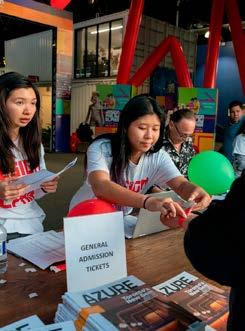
4 SPRING 2023 | context | AIA Philadelphia WWW.GENERALRECREATIONINC.COM 1-800-726-4793 Since 1996 Parallel Edge has focused on providing Outsourced IT support for AEC firms and other companies specifically working with the built environment. Outsourced IT Services when IT is not what you do. 610.293.0101 www.paralleledge.com OCT. 4 - OCT. 15 www.designphiladelphia.org *Must submit payment and all event info: Event Title, Event Location, Date, Time, Full Description, and Photo MAY 31 Early Bird Registration* Ends JUNE 30 Regular Registration* Ends JUNE 30 Advertising Registration Deadline




AIA Philadelphia | context | SPRING 2023 5 Rediscover the Many Benefits of Concrete Block. YOUR LOCAL CONCRETE PRODUCTS GROUP PRODUCER: resources.concreteproductsgroup.com Single Wythe Concrete Masonry is not only innovative, it’s also fire safe, affordable and beautiful. Visit our online Design Resource Center for the very latest in masonry design information - videos, BIM resources, design notes, and CAD and Revit® tools. www.beamltd.com
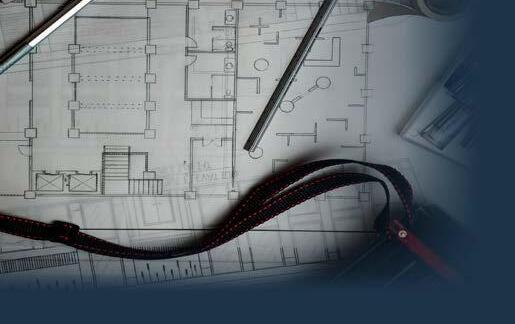


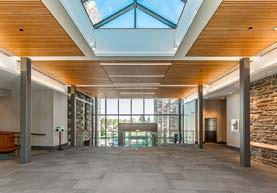


EPSA . (215) 709 3245 . info-usa@epsa.com EPSA IS PROUD TO BE A SILVER SPONSOR OF THE R&D TAX CREDIT TAKE ADVANTAGE OF STREAMLINED PROCESS & COMMUNICATION OPTIMIZED CALCULATION & SUBSTANTIATION COMPLIMENTARY FEASIBILITY & EVALUATION HELPING ARCHITECTURE & ENGINEERING FIRMS 938 Lincoln Avenue | Springfield, PA 19064 | Cumby.com | 610.328.5353 A third-generation, family-owned firm, W.S. Cumby Construction offers Construction Management, General Contractor, & Design Build services. Working in: • K-12 • Higher Ed • Religious • Historic Preservation • Non-Profit & The Arts • Country Club & Recreation Facilities • Multifamily Residential • Senior Living • Private Residential • Corporate
ELI STORCH, AIA, LEED AP Senior Associate, LRK Chair, Design Advocacy Group CONTEXT Editor
REBECCA JOHNSON Executive Director, AIA Philadelphia and Center for Architecture and Design
PHILADELPHIA’S NEXT MAYOR Must be an Agent for Change
The built environment must be among the primary concerns of the new mayor of Philadelphia because community development, housing policy, sustainability, resiliency, historic preservation, and design review touch on everything that happens in our city and its many diverse communities.
Bold change is needed. Minor adjustments and alterations to current policy will not get us where we need to go. The recommendations made in the following pages are beyond politics. We call on all our readers to consider them carefully, and we challenge those who want to be our next mayor to address each of these issues in their platforms. Those who face these challenges with a combination of realism and vision will find a dedicated community of allies ready to work hard to advance forward thinking policies.
We have brought together, both in this edition, and in person at the BUILDPhilly Mayoral Forum on March 14, some of the boldest thinkers in the fields of planning, design, development, and construction, all of whom share the goal of making our unique city even greater.
Across the breadth of the specific recommendations made by our contributors, based on their own experience and expertise, we are aligned in our steadfast belief in a greater Philadelphia. Greater means more equitable, more thoughtfully designed, more resilient and sustainable, and more eager to make the best use of our historic resources. We will have made progress towards this goal when all Philadelphians are able to live and work in a well-designed environment that provides comfort, safety, and inspiration.
As professionals who work on private and public projects, we engage closely with the agencies that review, regulate, coordinate, and manage our city’s built environment. It is only with their support and professionalism that we are able to create, and it is important to note here, as others will reiterate later in this issue of CONTEXT, that we harbor no antipathy for these agencies. These public servants, collaborators on all our projects, must be supported to the fullest possible extent. With their success comes success for us all. We must support them with adequate funding and engaged leadership.
AIA Philadelphia | context | SPRING 2023 7
EDITORS’ LETTER
JB&B is an MEP/FP consulting engineering firm that maintains a longstanding global reputation for building designs employing cutting-edge technologies to facilitate high-performance, energy-efficient and sustainable engineering.

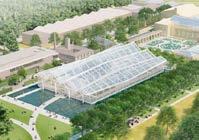
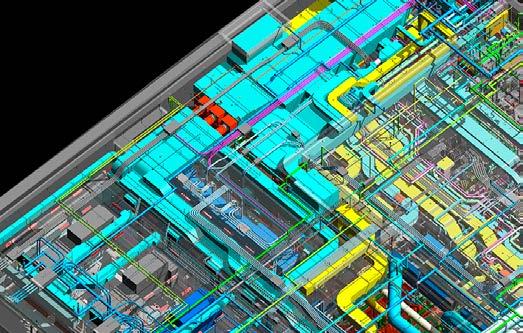
Philadelphia // New York // Boston WWW.JBB.COM
Make the Most of Your PA Tax Credits
Receive 90% Tax Credit on State Tax Liability

Are you a business or individual looking to contribute to the success of our Architecture and Design Education (ADE) program? You can now redirect your state tax dollars to the Center's ADE programming.
Thanks to the Architecture and Design Education (ADE) program, the Center is now an approved "Educational Improvement Organization" in the Commonwealth of Pennsylvania. This means we can accept donations and provide tax credits through the Educational Improvement Tax Credit Program.

8 SPRING 2023 | context | AIA Philadelphia
PROJECTS IN PHILADELPHIA AND SURROUNDING AREA
Virtua Health, Memorial Hospital, Care Optimization Project Penn State Liberal Arts Research and Teaching Building Penn Medicine, Overbuild at 3600 Civic Boulevard Curtis Center, Expansion Study and Make-Ready Lab Work 1, 7 and 8 Tower Bridge Cira Center
Jefferson Health Honickman Center © Neoscape for Ennead Architects
Longwood Gardens
Courtesy of WEISS/MANFREDI with Reed Hilderbrand for Longwood Gardens



AIA Philadelphia | context | SPRING 2023 9 Proud to be a part of Anderson Hall providing consulting & supply of acoustical wood ceilings for 34 years www.ssresource.com Steve Schultheis (484) 885-9259/(800) 777-0220 Proud member of AIA, CSI, IIDA Your Single Source for Ceilings, Walls & Facades Orion Federal Credit Union Headquarters LRK.com Community
Dear Friends and Colleagues,
This issue of CONTEXT is a special one for me because it is coinciding with the second BUILDPhilly Mayoral Forum that AIA Philadelphia has been instrumental in convening. BUILDPhilly (Built environment, Urban, Infrastructure, Land use, and Development) is a coalition of professional organizations and nonprofits addressing issues in the City of Philadelphia related to the built environment. Eight years ago, I worked with many colleagues to bring this Coalition together. We all agreed then, as we do now, that there is strength in numbers in terms of hosting a well-attended and thoughtful Forum, but also there is a tremendous opportunity to shape the future of our City, if we are able to collaborate more often and consistently. If there any funders out there that would like to support the continuation of this group’s advocacy muscle, call me!
Eli Storch, the editor of this issue, did an incredible job of identifying individuals to share their thoughts and recommendations with the next mayor of Philadelphia. Just like 8 years ago when this Coalition came together, it is validating to me that although the voices, perspectives,
and the organizations represented in the BUILDPhilly Coalition are diverse, there are several themes that emerge. It is my sincere hope that the next Mayor of Philadelphia, City Council members, and other City leaders see a common, shared path to designing and building the future of Philadelphia.
It is also my hope that you all see the passion, commitment, and generosity that these articles express. Not one opinion expressed here ignores the consequences of the recommendation suggested by the author. To the next Mayor of Philadelphia, please consider this as an expression of a sizable amount of common ground on which we can work together to create a prosperous, equitable, sustainable, and resilient Philadelphia.
Cheers, Rebecca
Register Today! Join your colleagues and friends for a day of golf on two of the area’s finest courses, lunch, an open bar, dinner, prizes, and more! The outing will again be held at Sunnybrook Golf Club and Whitemarsh Valley Country Club on Monday, May 8, 2023.

The Golf Outing supports programming that benefits the local architectural community’s efforts to engage K-12 students and emerging professionals. Visit the AIA Philadelphia website to learn more about the outing and register for the outing.

10 SPRING 2023 | context | AIA Philadelphia COMMUNITY PHOTO: FLICKER + ELM
Coming this April 27th at 5:30 PM, the AIA Philadelphia Annual Meeting and Committee Open House. Attend the annual business meeting and stay to meet with representatives of the nearly 20 committees of AIA Philadelphia and the Center for Architecture and Design. Committees are the lifeblood of our organizations and offer the best way to engage with the knowledge experts in the AIA Philadelphia community. This program will be an in-person event. Visit the AIA Philadelphia website to register and plan to attend.

AIA Philadelphia | context | SPRING 2023 11 COMMUNITY
DesignPhiladelphia is BACK and ready to take over Cherry Street Pier October 4-15. The festival will kick off on Wednesday, October 4th with an opening party at Cherry Street and events will follow throughout the city over the next 11 days. You’ll find hubs for design enthusiasts at the Center for Architecture and Design as well as Cherry Street Pier, a weekend for the kids, panel discussions, open houses, exhibition openings, interactive installations, hands-on workshops, and much more.
There are so many ways to get involved and connect with our audience of creative industry professionals, design-savvy public audiences, and students (particularly those in the creative industries).
of partnership to choose from, you decide if you want to host an exhibition, workshop, or panel discussion. The options are endless.
HOST AN OPEN HOUSE Have a studio?
An office? A shared space with other creatives? Bring the public to your place and show them what you do! Hosting an Open House during DesignPhiladelphia is super easy. Pick a date or dates and plan your time; all you need to do is be OPEN to the public. Serving refreshments is always a big hit, but certainly not required. Open Houses are meant to be free-flowing so that everyone has the same experience no matter what time they come, so please do not plan any programmed events during this time.
IMPORTANT DESIGNPHILLY DATES!

MAY 31
EARLY BIRD EVENT REGISTRATION ENDS
Must submit payment and all event info.
JUNE 30
REGULAR EVENT REGISTRATION ENDS
Must submit payment and all event info.
JUNE 30
ADVERTISING RESERVATION DEADLINE
JULY 19
ADVERTISING ARTWORK DUE
DESIGN AN INSTALLATION Show off your design chops at Cherry Street Pier with an interactive installation. We provide the space, you bring the team and your creative energy to breathe life into the pier and teach the public a lesson in design.
BECOME A SPONSOR Sponsor the DesignPhiladelphia Kickoff Party, an individual program, or one of our other experiential opportunities and let your brand do the talking to Philadelphia’s design world. Join the community of contributors who have supported DesignPhiladelphia in the past and connect with thousands of people here in Philadelphia.
ADVERTISE ON DESIGNPHILADELPHIA.


ORG AND/OR IN CONTEXT MAGAZINE’S
DESIGNPHILADELPHIA ISSUE Advertising on the DesignPhiladelphia website or in Context Magazine shows you value the design/maker community here in Philadelphia while putting your brand in front of thousands of design industry professionals daily.
PLAN AN EVENT
Join your fellow Philly designers and us by creating something special during the festival. Let us be your megaphone and bring the public to your space. Pair your creativity, your brilliance, your stories with our marketing muscle and wide-reaching connections to make your event a success. With several levels
CRAFT A DESIGN DISPLAY IN YOUR STOREFRONT WINDOW Not interested in hosting anyone? Use y our storefront as a window into your world by creating a Design Display on view throughout the entire festival, October 4-15.
VOLUNTEER We need your help to make the festival a success! DesignPhiladelphia volunteers help distribute marketing materials, get the word out about the festival using social media, support event hosts during the festival, and collect demographic information from participants during the festival. Keep an eye on the DesignPhilly website in the summer for when volunteer opportunities become available.
12 SPRING 2023 | context | AIA Philadelphia COMMUNITY
PHOTOS: CHRIS KENDIG
ARCHITECTURE AND DESIGN EDUCATION PROGRAM WELCOMES AUTISTIC SUPPORT CLASSROOM DURING THE FALL SEMESTER


Classroom 226 Sets the Bar High within ADE Program. In the past year, the Center for Architecture and Design’s Architecture and Design Education program has expanded in many ways. The program has made its way into 15 Philadelphia School District classrooms this fall, led by 32 volunteers. More than doubling in size since the beginning of the year, the program has had many “firsts” recently, but there is one that has truly touched everyone involved. Dara Fleischman eagerly welcomed us into her autistic support classroom, where she teaches seven 3rd-5th graders. Our team knew they would have to find extremely creative and dedicated volunteers for this class. The perfect fit came along when ADE joined forces with Beatriz Vergara Aller from WRT Design and Sam Siegel from Ballinger.
Ms. Fleischman, Sam, and Beatriz collaborated to design weekly lessons for the students, and the engagement and social-emotional growth were outstanding. Upon entering Fleischman’s classroom, you would see students deeply engaged in creating an entire model city while sitting at a table together. Beatriz was busy guiding students on how to creatively organize their streets, while Sam encouraged students to share ideas about building a bridge over a body of water. “This group work is usually not possible. Normally, I would spend most of the group work time redirecting students as it can sometimes be challenging,” said Fleishman. As students sat amongst their peers, they worked together to build a community with roads, street signs, homes, essential businesses, and even an airport. Fleischman commented that the students are so engaged in the ADE lessons that they can often carry on with them after volunteers leave, turning the topics into vocabulary or math lessons. Dara Fleischman also noticed an increase in attendance, specifically on days when volunteers were there. “My attendance has been perfect on Thursdays because they all want to be here when building the city with the volunteers,” she said.

One of the most remarkable yet simple moments was a young man answering a question one of the ADE team members had asked him. Although it may seem small, Ms. Fleischman later told us that the young man severely struggles with
communication, especially with strangers, and that the program likely built his confidence up so that he could express himself in new ways. The one undeniable thing about Ms. Fleischman’s room is the energy that fills it. Between Beatriz, Sam, Ms. Fleischman, and all the students, the room overflowed with curious energy and diligence that can only come from a genuine love of learning. This classroom is a stunning example of what can happen when students have access to architecture and design in the classroom.
AIA Philadelphia | context | SPRING 2023 13 COMMUNITY
MAYOR 2023
AN OPEN LETTER TO NEXT MAYOR OF

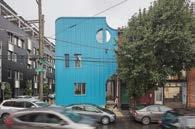
With the 2022 Midterms still in our rearview mirror, Philadelphians have another important election in 2023 as we embark to elect the city’s 100th mayor. The 2023 lineup of mayoral candidates presents a crowded and diverse slate of candidates, each of whom brings a unique perspective to the position.
AIA Philadelphia wishes to take this opportunity to challenge our mayoral candidates to address some critical, city-wide issues that contribute to the city’s success as a safe and thriving place to live, work, and play.
Dear Mayor,
Our city needs your leadership. Our city represents, in physical form, our society’s ideals and values. As you know, Philadelphia is a city with a rich past and a bright future. Over its distinguished history, Philadelphia has proven its resilience as it adjusts to, and anticipates, the needs and wants of its citizens. We emerge from the pandemic in an age of disruption, innovation, and social reckoning. Our public spaces provided relief from quarantine, facilitated civil protests, and provided safe spaces to gather throughout these recent years. Our buildings – old and new – are adapting to new uses and new technologies. At the same time, those same spaces have been the backdrop to an escalation of gun violence and a growing population of unhoused people.
HOUSING As is the case in many of our nation’s cities, Philadelphia is experiencing a housing crisis. A recent analysis by The Pew Charitable Trusts notes, “Nationally, researchers have found that there are two distinct kinds of housing affordability issues in urban America: one primarily caused by high housing prices and the other a result of low income levels. In Philadelphia, the issue is more the latter than the former. Among the nation’s 10 most populous cities, none has a higher proportion of cost-burdened households with low incomes than Philadelphia. Despite Philadelphia’s relatively low housing costs, many of our residents lack the income to find housing they can afford. The city’s supply of low-cost units is inadequate to meet the needs of this large group of households, “there are nearly twice as many low-income renter households as housing units they can afford.” City Council has been attempting to address this problem through Inclusionary Zoning initiatives, which require any new residential buildings above a certain size to provide a percentage of those units for affordable housing. These new laws only apply to specific council districts and need to be incorporated into a larger, holistic approach that strikes the right balance between tax incentives, zoning relief, and density bonuses to make these needed laws more comprehensive and impactful. Threading this needle will only be possible with public support, which requires the mayor to facilitate an honest, ongoing dialogue with the city’s residents - our neighborhoods need to welcome and support affordable housing development. Only mayoral leadership can rally public and private forces and give voice to the need for sustainable and enduring affordable housing.
14 SPRING 2023 | context | AIA Philadelphia
PHOTO: SAM OBERTER
A MESSAGE FROM AIA PHILADEPHIA
THE PHILADELPHIA
SUSTAINABILITY AND CLIMATE ACTION
Historically the City has been slow to adopt the most current Building and Energy Codes - but we must reverse that trend. Channeling our legacy of innovation, the City needs to adopt a climate-forward approach and adopt the most robust building codes available as a way to fight climate change and make significant progress toward a carbon-free city. Our buildings are significant contributors to the carbon crisis, through both the embodied carbon in the materials involved in their construction as well as their ongoing emissions due to the energy they consume to maintain heating, cooling, ventilation, and electrical systems. In fact, buildings represent nearly 40% of annual greenhouse gas emissions. We know that to reach the decarbonization targets set by the Paris Agreement, we must do more. Electrification, the shift to using electricity rather than burning fossil fuels like oil, gas, and coal for heating and cooking, affords our buildings the opportunity to utilize renewable and zero-carbon energy. Progressive legislators in peer cities have begun to require all-electric building codes as a primary means to fight climate change. For example, New York City recently barred most new building projects submitted for approval as early as 2024 from using natural gas or oil for heating, hot water, and cooking, with exceptions for critical facilities such as hospitals, and commercial kitchens. Former Governor Wolf’s veto of a State bill that would have prevented Philadelphia from mandating electrification offers you an opening to do just that. Our buildings must be resilient and adaptable, while also serving as our community’s first line of defense against environmental disasters and changing conditions of life and property.
BY JEFF GOLDSTEIN, FAIA, LEED AP 2022 AIA PHILADELPHIA PRESIDENT AND PRINCIPAL AT DIGSAU

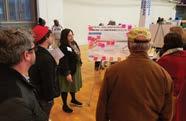
TRUST PLANNING
Through great effort, the Philadelphia City Planning Commission (PCPC) created Philadelphia 2035: The Comprehensive Plan for the city. The process was (and continues to be) inclusive, holistic, and professional. In the true spirit of Philadelphia, the recommendations are both practical and visionary. Unfortunately, executing the plan has proven difficult. Relative to peer cities, our planning department is severely underfunded, understaffed, and without sufficient power. The result is an unpredictable and parochial system that relies heavily on councilmanic prerogative and the private sector. The complexity of urban development, combined with the need to include the public, demands a robust Planning Commission. Currently, the PCPC is the second smallest of any major city in the US, with only 27 full-time staff planners. San Diego, California has approximately 300,000 less people than Philadelphia, but they have 80 staff planners, compared to our 27.
It is the responsibility of the mayor to ensure that the PCPC is given the resources it needs to do its job. This means increasing the size and funding of the PCPC, so that it can adequately advance the 2035 Vision and effectively review and approve projects. The Commission must have the resources to effectively engage with our communities and ensure that the voices of residents are heard and respected. By increasing the size and resources of the PCPC, the City of Philadelphia will be able to meet its process, sustainability, and equitable community engagement goals. This will result in a more predictable, equitable, and sustainable real estate development process in Philadelphia.
Our city faces great challenges, but also has great opportunities. Philadelphia’s physical assets - its structures, transportation systems, open spaces, and institutions have demonstrated their ability to adapt and anticipate social and economic shifts and will once again prove resilient and ready. The members of AIA Philadelphia practice, teach, research, serve, and lead organizations across the city and beyond, and are here to support the work we have ahead.
Sincerely,
AIA Philadelphia | context | SPRING 2023 15
PHOTOS: JEFFREY TOTARO (TOP), COURTESY OF THE PHILADELPHIA CITY PLANNING COMMISSION (RIGHT)
FOUR VALUES FORM A BASE FOR

EQUITABLE DEVELOPMENT
IN KENSINGTON AND BEYOND
To our incoming Mayor:
What a big job is ahead of you! In a city that is so rich, yet so inequitable in its distribution of resources, equitable development is just one of the many issues that you will face. But while it is one of many, it is also intertwined with all the challenges that you will be asked to face.
I write to you from the perspective of a resident of Kensington, of an urban anthropologist, and as the executive director of a community development corporation in Kensington whose mission is to advance social equity & economic empowerment by nurturing and creating opportunities for residents to live in, and actively shape, their neighborhoods of choice.
We would like you to be a partner in helping us to achieve that mission, and to do so, we need you to approach development from a new perspective.
Where should recommendations related to development lead? What is the goal?
I would argue that the goal is co-creating communities where those who have suffered the most benefit from the positive change you can lead. That communities have their needs met through an equitable and comprehensive approach to reducing disparities through the function of development, rather than being told to swallow the bitter pills of a profit-first approach.
Even though the Philadelphia communities facing the greatest disparities are also the least likely to vote or contribute to campaigns, that does not mean that these areas should be overlooked. They should be seen as essential to the overall progress of Philadelphia.
SO WHAT WOULD I SUGGEST YOU FOCUS ON?
I could list very specific items, such as the need for not using regional Area Median Income (AMI) as a tool to measure affordability in neighborhoods whose average household income is a third of the regional AMI. Very few current residents in these neighborhoods can afford “affordable housing” at 80% AMI. We need the mayor to lead a change where we stop connecting resources to strategies that don’t support Philadelphia’s existing residents.
BY DR. BILL M C KINNEY
We could focus on specific failed development strategies of the past that centered policing, lacked authentic community engagement, and treated residents as problems rather than addressing the systemic and intentional damage done to their communities.
But instead, I want to focus on four broader concepts as values that should be driving an equitable development approach that I think should be guiding Philadelphia.
• Comprehensive vision. We need the new mayor to recognize that equitable development does not happen in a vacuum; that for development to be successful it must be integrated into a holistic plan that addresses poverty, workforce development, health, education, racism, classism, and more.
• Community-driven action. We need you to start not only with a comprehensive approach, but also a community-driven one, which recognizes the strengths within our communities and shares power with residents in co-creating solutions. Community-led solutions are more sustainable because they are owned by those most affected by the outcome.
• Trauma-informed understanding. We need you to enter into your position of leadership recognizing the trauma within communities as a result of both intentional damage and failed strategies to fix that damage.
• People-centered focus. I ask that you always begin with people—and humanity—over profits. I ask that you shift from a scarcity mindset that believes the only way forward is to trade humanity for resources, toward an abundance mindset that recognizes Philadelphia’s most valuable assets are our residents.
I ask you to start your term by grounding yourself in these concepts before proposing any solutions so that these values are cooked into any movement you take.
16 SPRING 2023 | context | AIA Philadelphia
PHOTOS: NKCDC/LOWELL BROWN MAYOR 2023 COMMUNITY DEVELOPMENT
WHAT DOES EQUITABLE DEVELOPMENT LOOK LIKE?
One of the greatest tools of inequitable development is devaluing communities until they can be exploited. Amazingly, these same neighborhoods gain incredible value when they’re out of the hands of their long-term residents. Devalued, and then incredibly valuable the next week.
We must shift from a scarcity to an abundance mindset. While these neighborhoods may be lacking in resources under our control, we are rich in people. Let the economic value in communities be controlled by those that currently live in the community. Keep people in their homes and communities by investing in programs that focus on home repairs and fighting evictions and foreclosures, and use those moments to support small-scale landlords to be better landlords, and to help local BIPOC and women-owned businesses make the necessary repairs to homes.
When you begin with an approach that centers the people most affected in design and planning, it leads to a transfer of resources with the primary beneficiaries in the community you’re trying to serve because they are at the table when designing strategies for the allocation of resources. Implementation and management of the work should also be locally led, and assessment of success or failure should use community-based, participatory practices.
In a neighborhood like Kensington the cause of our challenges goes well beyond our community.
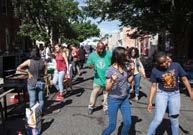
We need the next mayor to be a leader working with all surrounding cities, counties, and states on solutions to problems that impact our development. The drugs sold on our streets are not manufactured here, and most of the people who buy them are not from our community. The empty lots and neglected buildings on our commercial corridors are largely owned by absentee real estate speculators. The contractors who dump trash on our sidewalks don’t live next door. The policies and budgets for our schools, police, or justice system, which continue to make selling drugs an attractive option for many young people, are not set in Kensington. All of these issues are barriers to development, so we need you to be a leader throughout Philadelphia and beyond in building a regional approach to Kensington’s challenges.
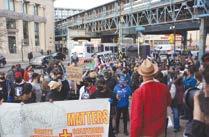
After years of many stakeholders operating in roles that are not
their strengths, we need you to help people find their proper seats at the table so that we can address the problems that prevent us from achieving our equitable development goals. For example, we need you to make clear that the city will not abdicate its role in development to developers whose mission is profit, not people. Yes, for-profit developers have a role, but if their bottom line is anything but achieving equity, they cannot lead the process. We have seen how it turns out. You have the power to help people get to the right seats and in the right roles.
Rather than succumbing to a trickle-down approach to development often pushed by those that will profit the most, I hope you will shift to an approach that recognizes “the true measure of any society can be found in how it treats its most vulnerable members,” as Gandhi said, and that a rising tide should lift all boats. Philadelphia is only as good as it treats its most vulnerable, and this reality should drive all policy decisions.
IN CONCLUSION
I started with values and theories of change because you have the opportunity to set the tone for the city and the region, and I think that role is critical. You have the opportunity to empower individuals with a shared set of values, the opportunity to fund projects that align with those values, the position to end relationships that reify failed strategies, and the means to start and grow new ones.
I ask that you put in the work it takes to bring more residents with new voices to the table, so that they can share both their vision and their expertise for what development in their communities should look like. Allow their passion to lead to their commitment to processes moving forward. With new people at the table and their priorities defined, listen—and ask nonprofits, developers, and others to listen—before setting plans for future projects.
Be a leader in co-creating communities. Be the partner that people so desperately need right now.
I live and work in one of the most challenging areas of city, but I have hope and I believe that, through grounded, values-based leadership, we can spur innovation and seize opportunities to reshape Philadelphia for the better.

AIA Philadelphia | context | SPRING 2023 17
Dr. Bill McKinney speaks to crowd at 2021 March for Safety and Solutions at Kensington and Allegheny Avenues, left. Residents participate in Community Cleanup Day near Auburn and Amber, center. Street dancing at 2017 party around Amber Street Garden
Dr. Bill McKinney is a Kensington resident and the executive director of New Kensington Community Development Corporation. He has a Ph.D. in Anthropology from Temple University.
A CLIMATE JUSTICE AGENDA
FOR THE NEXT MAYOR
In August of 2021, Hurricane Ida brought devastation through the Caribbean, Louisiana and ultimately north to Philadelphia and the surrounding region. High winds, heavy rains, and flooding resulted in stunning damage, perhaps most notably turning the Vine Street Expressway into a Venetian canal.
But while that storm and its impact made front-page news and received federal emergency funding to support its clean-up, it was actually the third major storm event within a year’s time. Just a few months prior, a 100-year flood event brought up to 10 inches of rain to parts of northeast Philadelphia as well as Bucks County. And one year prior to Ida, Tropical Storm Isaias devastated the Eastwick neighborhood of southwest Philadelphia.
Eastwick is one of the city’s lowest lying areas making it one of the most vulnerable to flood risk. For decades residents have experienced flooding events that have ruined property and forced people from their homes. Climate projections for Philadelphia indicate that flooding is likely to worsen due to a combination of sea level rise and increased frequency and severity of storms and Eastwick is among the neighborhoods that will experience the most direct impacts.
The reality is that climate change is no longer an issue of future projections and guesswork. The United Nation’s Intergovernmental Panel on Climate Change (IPCC) report¹ from February of this year notably indicated that not only have all past projections come to pass, but that the impacts are arriving even faster than predicted. The report further notes that there is less than a decade to take swift action in order to stave off the worst effects of climate change.
It is not overstating to say that addressing climate change is THE moral imperative of our lifetime.
Meeting this challenge will require accelerated action from all levels of government. The Biden-Harris Administration has taken historic action on climate change with the passage of the Bipartisan Infrastructure Law and the Inflation Reduction Act, which are poised to pump billions of dollars into clean energy technology deployment. However, it is local governments who are best positioned to deliver equitable climate solutions that suit local needs.
Philadelphia’s next mayor will take office in 2023 and, if elected to two terms, will govern over the most important decade for climate action. So, what should the next Mayor do?
BY CHRISTINE KNAPP
“WHOLE-OF-GOVERNMENT” APPROACH

Most importantly, the next Mayor should take a page from the Biden-Harris administration’s “Whole-of-Government” approach to the climate crisis. Tackling a problem of this scale cannot be accomplished by one office, or a few dozen city employees scattered throughout departments. Climate action must be embedded in every decision and every department, from housing and transportation to public safety and education. This approach includes appointing a cabinet-level senior advisor, similar to the role Gina McCarthy played at the beginning of the Biden Administration, coordinating climate policy across the Department of Energy, the Environmental Protection Agency, the Department of Transportation, the Department of Housing and Urban Development and many other agencies. In Boston, recently elected Mayor Michelle Wu has appointed a Green New Deal Advisor as a member of her cabinet to work across city agencies to deliver on policies that address climate change, build economic opportunity, and address equity. Both positions have the power of the chief executive behind them to drive progress and build collaboration among agencies.
Collaboration among agencies can help stretch limited municipal budget dollars further and bring multiple co-benefits. For example, Philadelphia’s heat equity index shows that some neighborhoods of the city can be as much as 22 degrees hotter than others and that areas with more extreme heat tend to be communities of color and low-wealth communities. These areas also tend to have some of the highest incidences of gun violence. A study conducted by the U.S Forest Service2 showed that some crimes — like drug possession — were significantly reduced in areas where green infrastructure had been installed. A cabinet level position could drive collaboration between the Department of Parks and Recreation, the Philadelphia Water Department, and the Office of Policy and Strategic Initiatives for Criminal Justice and Public Safety to focus on tree plantings and other green infrastructure in high crime areas to address both climate change and reduce crime.
18 SPRING 2023 | context | AIA Philadelphia
MAYOR 2023 SUSTAINABILITY
PHOTO: JOSH LIPPERT

AIA Philadelphia | context | SPRING 2023 19
Schuylkill River flooding during Hurricane Ida
ADVANCE ENVIRONMENTAL JUSTICE
Globally and locally, it is low-wealth and marginalized people, particularly Black, brown, and indigenous communities, who are most likely to be harmed by climate change, despite contributing the least to the problem. Climate change is an issue of racial and social equity, and a failure to address it quickly and equitably will harm our most vulnerable residents including the elderly, those with health conditions, and those with fewer resources to protect against or recover from its impacts. The next Mayor must ensure that all actions pursued to address climate change also addresses the environmental injustices experienced by our residents over many decades. Investing in, and empowering, the Environmental Justice Advisory Commission to play a more active role in City decision-making will go a long way. Tackling long-standing disparities in housing quality, access and ownership of land for urban agriculture and other uses, and the cumulative impacts of emissions from industry, highways, and other polluters can help make amends for the past while building a more equitable and sustainable future for all residents.
FUND CLIMATE-FOCUSED INVESTMENTS
Another priority for the next Mayor should be identifying increased and sustained funding mechanisms to drive investments needed to meet the scale of the climate crisis. With a need to make major reforms in our energy systems, housing, transportation and other infrastructure, cities around the country are now finding new and creative ways to bring resources to the fight. For example, on the other side of the state, Pittsburgh worked with Resource X, a consulting firm specializing in priority-based budgeting, to identify $41 million³ in the existing budget to direct towards climate, equity, and economic recovery, without increasing taxes. In a different example, in 2018 Portland voters approved the Clean Energy Community Benefits initiative4, which puts a 1% tax on purchases at large retailers to fund home energy retrofits for low-income residents and create green jobs. Consider, theoretically, a one cent tax on at home deliveries, which are causing traffic congestion in every neighborhood of the city, and how many millions of dollars such a tax could generate to expand and improve public transit while reducing congestion and harmful pollution. In a world where remote workers can locate anywhere, cities that invest in making their cities clean, green, healthy, and affordable are going to be those that attract and retain talent. Making climate-focused investments should therefore be a critical part of the economic growth of Philadelphia.
LEAD BY EXAMPLE
One of the easiest actions should be ensuring that the City leads by example in every way it can. That means the City should be upgrading its own buildings to reduce energy use, transition to cleaner energy, and prepare buildings like rec centers and libraries for future climate conditions. The City should take advantage of state and federal funding opportunities to transition the City’s fleet to clean and electric vehicles to reduce emissions and save money on fueling and maintenance. Providing recycling and composting in all City facilities, especially those that serve the public would set the right example and help keep our streets litter-free. The City’s parks and natural lands, including trees, should be preserved, protected, and invested in to maximize the benefits they provide to all residents. And the City should use the power of its large procurement needs to invest in local, Black and brown-owned businesses, and more sustainable products.
The City is also in a unique position as the owner of Philadelphia Gas Works (PGW). Gas use is not only a major source of emissions, but studies are now linking the use of gas stovetops as a cause of childhood asthma5. The next mayor must push PGW to transition to become a clean utility that provides necessary energy services while improving public health and ensuring rate affordability. The next Mayor can appoint members to the Gas Commission and the Philadelphia Facilities Management Corporation that will hold PGW accountable to specific carbon reduction goals and a diversified business strategy.
EXPAND PARTNERSHIPS
The next Mayor must create new partnerships to carry forward the work necessary to meet the scale of the problem. For example, the next Mayor could work with:
• Housing agencies to create more affordable, energy efficient and climate-resilient housing.
• The Philadelphia School District to ensure their next facilities master plan has a clear plan for creating modern, healthy, and climate-ready buildings that foster learning.
• The Delaware Valley Regional Planning Commission and surrounding counties to build out an electric vehicle-charging strategy.
And critically, the Mayor needs to work not only with City Council, but also use their platform to push state and federal agencies to advance policies that allow Philadelphia’s ambitions to become a reality.
These recommendations are by no means simple, they require considerable policy effort and broad buy-in to achieve. To succeed, Philadelphia’s next mayor must instill the appropriate collaborative mentality, beginning during the campaign acknowledging the immediacy and importance of these issues. With that committed, clear, stated direction, Philadelphia can begin to coalesce around an inclusive and equitable vision for our climate future.
Christine Knapp serves as the Manager of the Community Innovation & Technical Assistance team within the Office of State and Community Energy Programs at the U.S. Department of Energy. She previously served as the Director of the City of Philadelphia’s Office of Sustainability.
CITATIONS
1. https://www.ipcc.ch/report/ar6/wg2/
2. https://www.fs.usda.gov/research/news/highlights/green-stormwaterinfrastructure-reduces-crime
3. https://the-atlas.com/projects/budgeting-for-climate--the-city-of-pittsburghrepurposes-resources-for-a-sustainable-future-1698

4. https://www.portlandoregon.gov/auditor/article/674246
5. https://www.mdpi.com/1660-4601/20/1/75
20 SPRING 2023 | context | AIA Philadelphia
Members of Philadelphia’s first Environmental Justice Advisory Commission were appointed in February 2022
PHOTO: CHRISTINE KNAPP
“CIVIC” IN DESIGN REVIEW
BY NANCY ROGO TRAINER, FAIA, AICP
A WELL-DESIGNED
PUBLIC REALM
THE

IS
FUNDAMENTAL TO
QUALITY
SUPPORTING THE 1
OF URBAN LIFE. With any luck, this simple statement is already a core tenet of the next Philadelphia mayor’s belief system. In a broad, civic-minded definition, a well-designed public realm — streets, sidewalks, parks, and other shared spaces — is one that promotes the creation of what urban ethnographer Elijah Anderson calls the “cosmopolitan canopy,” a place where all feel welcome and safe, where civility is the order of the day. In short, a place people want to be.
Philadelphia’s Civic Design Review (CDR) process was designed to promote these four core concepts by focusing on civic, shared spaces — and on the height, bulk, transparency, and materials of the buildings that shape them. CDR is rooted in a fundamentally optimistic view of both development and the design process, with guidelines that are more aspirational than prescriptive; they suggest that development be compatible with the neighboring context, for example, but do not specify materials or particular design features. The regulations governing CDR explicitly state that the process is “not intended to evaluate the architectural style or compositional aspects of a project outside of their clear impact on the public realm.” Neighborhood representatives have meaningful roles in the review — with seats at the table both literal and figurative. CDR was designed to promote the collective goodwill of designers, developers, and neighborhood groups — and, as it is advisory only, relies on this goodwill for its success. When this goodwill is present, the process works — sometimes beautifully. But often, it doesn’t, and design improvements made in response to CDR comments are either too marginal to make a difference or never carried through to construction.
As Chair of the CDR Committee from its inception in 2013 through 2020, my thoughts about design review are informed by that perspective; and as a result, my recommendations focus on ways of facilitating the good faith and optimism necessary for the Civic Design Review process to work.
Devote energy and resources to develop policies that respect and preserve Philadelphia’s unique, character-giving qualities — its mix of old and new, remnants of its industrial past, its diversity of neighborhoods — and ensure that new development will be woven into this extraordinary existing fabric.
Too often, by the time the Civic Design Review Committee reviews projects, existing buildings have been demolished or approved for demolition — cutting off all discussion about the design value of preservation. In too many cases (Jewelers’ Row, for example), this results in unproductive, unsightly gaping holes that persist for years — a “lose-lose” scenario precluding preservation without the promised benefits of new development. Potential solutions could range from conditioning certain demolition permits on completing Civic Design Review for replacement structures and on commitments to a timeline for construction to providing bonuses, financial credits, or other additional incentives for reuse of existing buildings. In the most optimistic scenario, incentives would be robust enough to put developers in the position of arguing for the character-giving aspects of existing buildings — not unlike a period in the 1980s when developers worked to get historic designations to qualify for Historic Rehabilitation Tax Credits
AIA Philadelphia | context | SPRING 2023 21
MAYOR 2023 DESIGN
REVIEW
Give community members reason to believe that renewed, well-designed neighborhoods will benefit them, and that amenities brought by new development—the very thing that they are investing their time to discuss — will not make them feel like outsiders in their own neighborhoods.
>> P romote affordable housing — in every neighborhood. The biggest impediment to goodwill in many CDR discussions is community members’ suspicion that low- or middle-income people will be displaced, and that the neighborhood the developer is envisioning doesn’t include them. Whether based on past experience or their expectations for the future, neighbors of proposed development understand the potential of new construction to raise market rent and sales prices for nearby properties, making the neighborhood inaccessible to longtime residents and their families.
>> Ensure that affordability is closely linked to existing neighborhood incomes so that long-term residents can see a place for themselves and their families in the neighborhood as properties are developed.
>> CIVIC DESIGN REVIEW ADDRESSES THE FOLLOWING:
1 W hat is the existing context of the site in the surrounding neighborhood?
2 How will the proposed project function in the neighborhood?
3 Does the proposal enhance neighborhood qualities?
4 Is the proposed project compatible with the character of the neighborhood?
5 Has the local community organization b een engaged?
>> Create a more direct link between height and density bonuses and proposed project locations. Allowing developers to receive bonuses for paying into the Housing Trust Fund puts the burden of those bonuses on a specific community without any guarantee that the funds will produce or protect affordability in their neighborhood.
>> Focus attention on the shared public realm and encourage design that is both contemporary and contextual, building on the styles, scales, and textures of its particular, unique location. Often, community members see the emphasis on architectural design features like gray brick or metal facades, roof decks, and dog parks as entirely foreign to their neighborhoods, less as amenities than as symbols of gentrification and harbingers of exclusion.
4Devote to the Planning Commission the staff and resources it needs not only to review projects, but also to follow those projects as they are permitted and completed, and to make recommendations to improve the CDR process as needed.
3Redesign the process to add more “teeth” to the review while maintaining its aspirational, non-prescriptive qualities.
>> THE PROCESS: Determination of Requirement by Licenses & Inspections (L&I)
A pplicant submits materials to PCPC staff. See deadlines below.
Use the prospect of additional reviews to incentivize architects and developers to prioritize Philadelphia’s public realm in their initial submissions and to show substantially improved designs when required to return for a second presentation. Too many developers build two trips to CDR into their schedules and, sometimes, present no meaningful change on a return visit. This is a waste of the Committee’s and the community’s time and encourages cynicism about the process itself. (I once overheard an architect advise a client that “it doesn’t matter what the Committee says, the worst they can do is make you come back with the same design.”) A redesigned process, for example, could give the Committee the ability to require the developer to return more than once in particularly egregious cases; to avoid drawn-out review processes as a matter of course, agreement of two-thirds of Committee members present (rather than a simple majority) could be required to trigger a third — or fourth — visit to the Committee.
N otice to and meeting with Registered Community Organization (RCO)
R eview and recommendations by Civic Design Review Committee at advertised meeting
P otential 2nd submission and 2nd review meeting
P CPC sends letter to L&I CDR Process is complete
Creating such incentives for architects and developers to “do better” would allow CDR to be more effective while maintaining its aspirational, non-prescriptive qualities, qualities that respect the creative process and reflect a deep faith in the design profession. CDR recognizes that Committee members who have spent a few hours reviewing plans cannot solve all the issues inherent in making a design better; instead, the process places the faith and responsibility for doing so in the design professionals who have spent months, or even years, thinking through every aspect of a project. Keeping the guidelines aspirational and focused on the public realm allows reasonable, spirited dissent among Committee members without inhibiting or stalling good development, diluting creativity, or devolving into “design by committee.”
The Planning Commission staff includes talented and dedicated public servants, whose expertise and city-wide perspective are critical to the CDR process. Allowing the Commission the time and resources to monitor projects as they move through construction and to document findings would help the public understand whether developers are honoring the design changes they have committed to in public meetings, a critical factor in building the goodwill necessary for an advisory-only review process to have a positive impact. Additional investment in the Planning Commission would yield greater accountability and, ultimately, a city whose development more closely aligns with its stated ideals and aspirations.
Along with some seemingly intractable challenges, Philadelphia’s next administration will inherit an extraordinary diversity of neighborhoods, building types, urban textures, and a myriad of opportunities to create a more welcoming and livable public realm. My hope is that Philadelphia’s next mayor is idealistic enough to envision the physical city as a setting and an engine for a more equitable and engaging civic life, and pragmatic enough to make that vision a reality.
Nancy Rogo Trainer, FAIA, AICP, was Chair of Philadelphia’s Civic Design Review Committee from 2013 through 2020.
2
22 SPRING 2023 | context | AIA Philadelphia
>>>> >>>> >> CHARTS SOURCED FROM: CITY OF PHILADELPHIA –CIVIC DESIGN REVIEW BROCHURE 2023
PRESERVATION PRESCRIPTIONS
FOR A PROSPEROUS PHILADELPHIA
BY PAUL STEINKE AND PATRICK GROSSI

In August 2016, word spread that a demolition notice had appeared on Philadelphia’s historic Jewelers Row, the second-largest jewelry district in the nation — and by some estimates, the nation’s oldest. We at the Preservation Alliance were incredulous and outraged. How could this be happening on Jewelers Row, one of the most intact and architecturally distinctive commercial blocks in the city, a magnet for locals and tourists alike? But to our shock and dismay, there it was: a big orange sticker declaring that four buildings — 702, 704, 706-08, and 710 Sansom Street — dating as far back as 1865 and occupied by functioning jewelry businesses, were slated for the wrecking ball. Toll Brothers, a high-profile housing developer from nearby Horsham, PA, had quietly assembled a parcel on which they proposed a shiny new, condo tower totally out of scale with the surrounding low-rise historic buildings.
What ensued was a preservation battle the likes of which Philadelphia has rarely seen, even making the pages of the New York Times. Philadelphia Mayor Jim Kenney issued a characteristically bland, anodyne statement indicating his preference that the buildings be preserved. But in the end, the mayor’s statement had no teeth, and the developer knew it. So, they followed through and bulldozed the buildings in 2019, evicting multiple businesses from the Row and leaving a gaping hole that remains to this day.
That’s when we took the saying, “Never waste a good crisis”, to heart. In the end, we lost the battle to save that chunk of Jewelers Row. But the public outcry generated by the destruction helped lead to important reforms in Philadelphia’s municipal development policies. To be sure, the loss of irreplaceable historic structures didn’t end with Jewelers Row. Painful demolitions since then include Our Lady of the Rosary Church at 63rd & Callowhill, the home of artist Joseph Pearson in Germantown, and the 12th Street Gym complex in Washington Square West. Nevertheless, preservation policy reforms enacted since then are at last beginning to pay off.
As evidence, the website Rent Café recently reported that, in 2020 and ’21, Philadelphia was #2 in the nation in the conversion of old buildings to apartments, surpassed only by Washington, D.C.1 New zoning incentives for historically designated properties passed by City Council in 2020 are starting to have an impact: according to the Philadelphia Historical Commission, almost two dozen his-
toric properties have taken advantage of the new zoning, parking, and accessory dwelling allowances. In addition, the city’s 10-year tax abatement was scaled back for new residential construction starting in 2022 but remains in full force for the rehabilitation of existing buildings, amounting to the city’s first real financial incentive for building reuse in at least two decades. Alas, these reforms all came too late to prevent the Jewelers Row debacle, but they point to a better future for our city.
In addition, neighborhood advocates, alarmed to see their historic built environments come under assault during the last decade’s construction boom, have led the way. Recent examples include the creation of new local historic districts on Christian Street/ Black Doctors Row, in Powelton Village, and in Victorian Roxborough.
It is vitally important that Philadelphia build on this progress under the next Mayor and City Council. In the more than three centuries since its founding, Philadelphia has played a crucial role in every era of American history. Our vast building stock reflects that historical significance. Nearly 70% of Philadelphia’s buildings were built before 1945, and the city is replete with architectural and historic landmarks, streetscapes, and neighborhoods that should be the envy of urban centers around the world.2 If the city is to remain a choice destination to live, work, and raise a family, our neighborhoods need and deserve historic protections and investment to strengthen their vitality and appeal.
AIA Philadelphia | context | SPRING 2023 23
2023
MAYOR
HISTORIC PRESERVATION
1. ADEQUATELY FUND THE HISTORICAL COMMISSION
Despite modest increases in staff size under the Kenney administration, the funding and staffing levels of the Philadelphia Historical Commission (PHC) remain insufficient. The Commission operates with a budget under $1 million, an allocation that compares unfavorably with most of our urban peers. In this most historic of American cities, home to more than 500,000 buildings, the PHC relies on the dedicated work of merely nine staffers (only seven of which are preservation planners handling day-to-day business).
The creation of new local historic districts, including those named above, has added greatly to the PHC’s daily workload and only further reiterates the need for increased staff capacity. Furthermore, the PHC would be the appropriate agency to manage the proposed and essential Citywide Survey of Historic and Cultural Resources (see below). If Philadelphia is to have a nimble, modern, and efficient Historical Commission, it must be adequately funded and enabled to fully pursue its mission as outlined in the City’s Preservation Ordinance.
2. IMPLEMENT PARTIAL CONTROL DISTRICTS
A current barrier to historic designation of individual properties and/or inclusion in a local historic district is the perceived burden for property owners. Some owners are reluctant to acquiesce to what they view as onerous guidelines on maintenance and alterations and their associated costs. A Partial (or “Soft”) Control District would address those concerns, focusing primarily on the preservation of scale and historic character, while still regulating demolition
and new construction. Such districts would more readily accept modern replacement materials (windows, doors, roofing, etc.).
Our existing Neighborhood Conservation Overlay Districts (NCOs) already exemplify this approach, but they only partially regulate “speculative” demolition. An outcome of the Task Force, demolition permits within NCOs must now be accompanied by a valid building permit. In other words, an otherwise safe property cannot be demolished unless a viable plan is also in place to build something new in its place. NCOs have had reasonable success, but they are primarily intended to guide the design of new, infill development.
Creating a new, more flexible form of historic district was among the key recommendations of the Mayor’s Historic Preservation Task Force. The Department of Planning and Development and PHC have both endorsed the idea in concept. A more flexible historic district also has promise to better recognize communities less defined by high-style architecture and more noteworthy for consistency of scale, building type and cultural heritage.
3. STRENGTHEN MUNICIPAL INCENTIVES FOR HISTORIC PRESERVATION
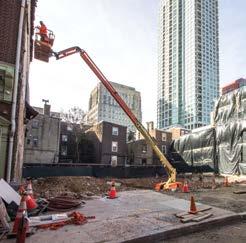

There are currently few economic or procedural incentives for the preservation and rehabilitation of historic properties in Philadelphia. The most popular and effective program is the Federal Historic Rehabilitation Tax Credit. Buildings eligible for that program must be “income-producing” and listed (or deemed eligible for inclusion) on the National Register of Historic Places (NRHP). Pennsylvania offers a similar, though less generous, state tax credit as well. Both programs are typically most advantageous to developer or institution-driven, large-scale projects (though federal legislation is under consideration to make the program more accessible to smaller-scale operators).
The City of Baltimore, by contrast, administers a mirror of these programs at the municipal level, offering a ten-year tax credit for both homeowners and commercial property owners within the city’s 70+ historic districts. Existing properties in Philadelphia, historically designated or otherwise, are currently eligible for the city’s ten-year tax abatement. But the abatement is limited to the cost of “improvements,” a benefit which typically pales in comparison to the much greater abatement afforded to new construction projects. Even with the recent amendments to the abatement, which curtail abatements for new
24 SPRING 2023 | context | AIA Philadelphia
Here is our wish list for the city’s next generation of leadership:
Jeweler’s Row, during demolition, left, and after.
PHOTOS: MICHAEL BIXLER
construction, rehab projects are often misperceived as unwieldy or excessively costly. Adjusting the basis of the rehabilitation abatement (such that very extensive rehabilitations effectively reduce the base value of the property to zero — and render the entire project an “improvement”) may be a further corrective to this.
The City of Philadelphia did adopt three procedural incentives in early 2020, each of which was a key recommendation of the Historic Preservation Task Force. They include Use Zoning Relief, Parking Minimum Relief, and the allowance of Accessory Dwelling Units (ADUs) at historically designated properties
Whatever the path, direct monetary assistance to owner-occupants of historic homes (particularly low-to-middle income households) and owner-operators of small businesses is most sorely needed. Reduced tax assessments, homeowner repair grants, and/ or low-interest loans are the most effective means. Also, augmenting existing programs to prioritize or more highly reward historic properties (i.e., Restore, Repair, Renew; Basic Systems Repair Program; Weatherization Assistance Program; Storefront Improvement Program, and the newly created Whole Home Repairs program) would be a simple approach with high impact.
4. COMPLETE THE CITYWIDE SURVEY “TELL THE FULL STORY”
In summer 2022, the Department of Planning and Development and PHC launched a pilot Cultural Resource Survey. PHC has also adopted GIS software to facilitate future survey work. Much of this effort is being made possible by a grant from the William Penn Foundation. The city has never conducted a comprehensive citywide survey of historic resources, an essential document that would help guide future development initiatives and preservation best practices. By providing a clear and thorough assessment of the city’s historic properties, we can ensure that the buildings and spaces we cherish stand proudly alongside the welcome new developments throughout Philadelphia. Though the preservation community has been clamoring for such a survey for over three decades, the need has never been greater. A Cultural Resource survey will ensure that properties reflecting the city’s diverse heritage will be appropriately recognized, with increased emphasis on the places and spaces that tell the broad history of nonwhite Philadelphians. Moreover, a Cultural Resource Survey would expand the field of places and spaces worthy of recognition, with decreased emphasis on architectural style, and increased emphasis on civic, political, and communitybased contributions.
5. BUILDING REUSE IS CLIMATE ACTION
We preserve buildings to honor our collective past, to recognize architectural achievement, to sensibly manage change. But we must also begin to more forcefully recognize the material, environmental benefit of preserving old places and the ways in which they can help forestall the dramatic and disruptive impacts of a changing climate.
Since at least the 1970s, preservationists have argued for the environmental and ener-

gy-saving benefits of preserving historic places. In 2007, Maryland architect Carl Elefante distilled this idea into a now much-quoted mantra: “The greenest building is one that is already built.”3 As the city contends with the dramatic and ongoing effects of climate change, historic preservation, and intentional building reuse are necessary components of any sensible and holistic approach.
The demolition of existing buildings and subsequent construction of new buildings not only contributes greatly to energy consumption and an ever-growing waste stream, it also discards decades of “embodied energy,” the extracted material, labor, and finite resources invested in that building’s original construction.
Multiple reports, from respected organizations like the National Trust for Historic Preservation and independent organizations associated with the architecture and building trades have concluded that building reuse, paired with modernized energy efficiency performance, produces the lowest carbon footprint relative to new construction.
6. EXISTING HOUSING IS AFFORDABLE HOUSING
Similar to the above credo regarding our “greenest buildings,” housing advocates often contend that the most affordable home is the one someone already lives in. In tandem with the above recommendations for direct homeowner assistance, helping owneroccupants and small landlords maintain their aging properties allows families and individuals to age in place, avoid the hardships and disruptions of an unexpected move, bolsters public health, and helps preserve what is recognized as Naturally Occurring Affordable Housing (NOAH).
The city’s vast supply of vacant and underutilized historic properties further provides opportunities for newly created affordable housing, whether via rehabilitated rowhouses or larger structures that can accommodate multi-family developments. Former schools, in particular, have proved particularly adaptable as affordable housing options within a historical setting, such as Project Home’s Maguire Residences in a 1907 former elementary school in Kensington. Some trace the beginning of the modern preservation movement to the demolition of Penn Station in New York City in the early 1960s. Perhaps historians will look back at the losses on Jewelers Row in 2019-20 as the moment that the tides changed for historic preservation in Philadelphia. After all, we hold title to the claim of America’s most historic big city. It’s about time we started acting like it.
Paul Steinke has served as executive director of the Preservation Alliance for Greater Philadelphia since June 2016 after serving on the organization’s board for many years. Patrick Grossi serves as Director of Advocacy for the Preservation Alliance, a position he has held since March 2015.
CITATIONS
1. RentCafe, “Adaptive Reuse Apartments Up 25% from Pre-Pandemic Numbers, Led by Record Office-to-Apartment Conversions,” December 20, 2022, https://www.rentcafe.com/blog/rental-market/market-snapshots/ adaptive-reuse-apartments/
2. National Trust for Historic Preservation’s Preservation Green Lab and Urban Land Institute Philadelphia, Retrofitting Philadelphia: The Partnership for Building Reuse, September 2014; https://forum.savingplaces.org/connect/community-home/librarydocuments/viewdocument?DocumentKey =981d6c61-aefb-4a18-a34b-c6098a82b178&tab=librarydocuments&CommunityKey=00000000-0000-0000-0000-000000000000
3. Carl Elefante, AIA, LEED AP, “The Greenest Building Is… One That Is Already Built,” Forum Journal: Viewpoints, Summer 2007 (National Trust for Historic Preservation); https://forum.savingplaces.org/viewdocument/summer-2007-forum-journal-viewpoin
AIA Philadelphia | context | SPRING 2023 25
DEVELOPING A PREDICTABLE
HOUSING POLICY FOR PHILADELPHIA
In developing a successful, housing policy for Philadelphia, predictability should be the single most important goal for all elements of the process. The city should work toward eliminating confusion and building consistency into every aspect of the real estate development process to attract the investment that Philadelphia needs and avoid costly delays and unexpected expenses. Doubt and uncertainty equate to risk, and good developers, the type that we should be encouraging to invest in our city, look to limit risk wherever possible.
To that end, the following recommendations are intended as achievable goals which, when implemented, will pave the way towards a more clear and linear development process.

OVERLAYS OFTEN FRUSTRATE THE UNDERLYING ZONING CODE
Overlays and councilmanic district exemptions undermine the zoning code, expose the city to legal challenges, and create a patchwork of regulations with little to no consistency from one neighborhood to the next. A recent writeup showed that over 70% of city land has at least one overlay imposed. Between the Planning Commission, Registered Community Organizations (RCOs), and development agencies, our city is replete with the expertise to thoroughly vet proposed overlays to ensure consistencies with the underlying zoning and that sufficient community awareness and support exists. Equally troubling from the perspective of a developer or a Philadelphia resident, without a thoughtful and rigorous process to impose any overlay, neighborhoods can be reshaped against the desires of the community and the development process, in turn, becomes even more unpredictable.
STRENGTHEN THE PROCESS
The planning and development process is often unpredictable, however, there are opportunities for it to be strengthened in the following ways:
• The Planning Commission should be allowed to do its job without encumbrance and remap the city with uniform requirements that encourage smart and equitable growth and an adequate supply of housing.
• Certain larger-scale projects should be deemed “uncontested”, if they can meet stated criteria, and allowed to move forward through zoning if Civic Design Review (CDR) is unable to schedule a meeting within 90 days. A policy that gives CDR a 3-month timeframe to hear a case would cement the predictability needed when constructing a development schedule.
BY MO RUSHDY
• City agencies should also coordinate closely with RCOs to develop a consistent and predictable process in all neighborhoods of Philadelphia. If the City is going to continue relying upon RCOs for feedback and review in the development process, then the City should accept the responsibility for supporting the organization and professionalization of these community organizations. Right now, community groups have wildly different levels of funding and expertise, leading to costly unknowns when pursuing development opportunities in different sections of Philadelphia.
• And yes, these items all require additional support and resources to be committed, because to grow, smartly and equitably, investments in the Planning Commission, among other city agencies, are a small price to pay given the additional value that they can add, in terms of improved process and ultimately, better development projects completed more quickly.
In summary, predictability. Goals for affordable housing and equitable community engagement could be realized if developers and owners were able to plan more efficiently because they could make realistic budget decisions for the development process.
AFFORDABLE HOUSING POLICY THAT WILL WORK
Creating an affordable housing policy that will meet the need of the number of Philadelphia residents who need access to affordable housing is difficult. It is an issue that many private and public sector leaders have been working on for years. The solution needs to be multi-faceted and not rely solely on the private sector to create the bulk of affordable units. There are some issues that are lower-hanging fruit where the City could quickly and efficiently aid in the production of thousands of affordable units.
PROPERLY RE-DISTRIBUTE UP TO 10,000 CITY-OWNED VACANT LOTS.
Philadelphia has thousands of city-owned vacant parcels available for affordable housing and it is critical that disposition decisions be made by the Land Bank, not City Council. A non-competitive land disposition policy was passed 2 years ago¹ which allowed the transfer of land to qualified applicants who would deliver projects with only a 51% affordability component and a 49% market rate component. (Legislation 190606). This policy allows market rate housing on nominally priced
26 SPRING 2023 | context | AIA Philadelphia
MAYOR 2023 DEVELOPMENT
land, allowing developers to cross subsidize the affordable component reaching deeper affordability. In essence instead of building 20 homes all at 120% AMI, a developer could do 9 market rate homes, maybe 3 at 120%, 5 at 80% AMI and 3 at 60% AMI. With proper support in this land distribution process, this public/private partnership can yield 5,0006,000 new home ownership opportunities, along an additional 10,000 rental units.
ADDITIONAL FINANCIAL INCENTIVES TO BOOST AFFORDABLE HOUSING PRODUCTION:
• Pennsylvania’s recent passage of HB 581, allows council to pass a 100% 10-year property tax abatement for affordable housing construction, expanding on the recent adoption on a commercial corridor in the 5th district to the entire city.
• The 1% Construction Tax was passed to create affordable housing and both public and private sector developers need easier and clearer access to its funds to efficiently produce the affordable units proposed.
• Housing policy should support density and the use of mass transit and reduce parking requirements. The low- and moderate-income housing bonus program was recently changed, increasing in-lieu-of (ILO) fees to an appropriate level to support affordable housing development, but the height bonus was removed. Without the additional height, an increase in allowable units was not sufficient to justify the cost and the City has seen a dip in ILO fees and a lack of constructed affordable housing, based on this policy chance. Instead, the City should:
° Reinstate the height bonus while keeping the high ILO fees
° Reduce the 50-year deed restriction down to 15 years
MANDATORY INCLUSIONARY ZONING DOES NOT WORK
Mandatory Inclusionary Zoning (IZ) requires that a percentage of units in an otherwise market rate project are deed restricted for 15+ years with target specific lower rent prices, allowing people who meet the income requirement to acquire housing.
Simply put, Mandatory Inclusionary Zoning is not executable in Philadelphia and it will not deliver affordable housing at scale.
Private development relies on debt and equity for the financing of a projects. For simplicity, assume 25% of project cost comes from sponsor or investor equity and 75% comes from bank debt financing. To be able to secure the equity and debt, certain parameters must be met.
For the debt portion, the net operating income (NOI) of a building must cover the mortgage payment by a 1.25 ratio, called the Debt Service Coverage Ratio (DSCR). In other words, if a building has an NOI of $1,000,000, the maximum mortgage payment that would allow an approved loan cannot exceed $800,000.
For the equity portion, a project pencils out if the annual cash on cash (annual new cash flow/invested equity) is over 7.5%. If a $10 million development project with an equity requirement of $2.5m is to be feasible for the sponsor equity, the annual cash flow needs to reach $187,500 on that $2.5m investment.
A model was run over 500 times by the Building Industry Association
of Philadelphia to test these 2 parameters (DSCR and Cash on Cash) at different project densities, various land costs, as well as various affordability components. This analysis demonstrates comprehensively that it is difficult to make a project pencil out without accompanying incentives to bridge the financing gap. In summary:
• In low revenue markets such as Philadelphia’s neighborhoods (this analysis is based on Kensington), ANY inclusionary zoning does not work, REGARDLESS of density. Implementing IZ policies results in non-financeable projects.
• A $1,000 discount per month in rent is equivalent to a $200,000 private subsidy for that unit.
• This analysis was completed roughly a year ago with a 5.0% financing rate. In today’s 7% interest rate environment, even borderline viable projects become infeasible, which is partnered by 15-20% increases in construction costs, even borderline viable projects become infeasible.
• Critically, mandatory inclusionary zoning can result in a 15-20% increase in market-rate rents to close the financial gap, making ‘naturally occurring affordable housing’ much harder to achieve. This creates the potential for exacerbating wealth gap and gentrification concerns in the process of creating affordable housing.
• Increasing density has its limitations. As density increases, taller more complex structures counter density gains based on increase per square foot construction costs.
The need for affordable housing, and more housing in general, is at a high in Philadelphia, and to achieve the required growth, the public and private sectors must work collaboratively.

Simple policy changes, and increased support for those within the development process, as outlined above, will produce more affordable housing units from the private development community. There still will be a need for other nonprofit and government agency programs to meet the overall need we have in Philadelphia – but without the recommendations outlined here, the private sector will not be able to contribute towards solving this issue at the scale required.
CITATIONS
1. https://phila.legistar.com/LegislationDetail.aspx?ID=3991752&GUID=14725D10-0 311-4DE9-8907-7FE25A3D562B&Options=&Search=&FullText=1
2. https://www.legis.state.pa.us/cfdocs/billinfo/bill_history.cfm?syear=2021&sind=0&body=H&type=B&bn=581
AIA Philadelphia | context | SPRING 2023 27
Mo Rushdy is a Managing Partner of The Riverwards Group and serves as the Vice President of Building Industry Association of Philadelphia.
c COURTESY
OF THE PHILADELPHIA CITY PLANNING COMMISSION
PHMC AT 4601 MARKET STREET
FIFTEEN Architecture + Design
FIFTEEN, along with its partners, is focusing the conversation on Design and a Philadelphia that prioritizes health and wellbeing.
PHMC’s 4601 Market Street Project renovates a prominent historic building in West Philadelphia to bring outreach, health promotion, education, research, planning, technical assistance, and direct services to the community. The new space allows PHMC to provide a range of child and familyoriented services under one roof. The facility is designed to inspire health and well-being, and to deliver a client-centered, family-inclusive experience. Over seven programs are housed under the same roof; bringing physical, mental, and education services to the West Philadelphia Community. These programs include The Center for Autism, The Millcreek School, Community Mental Health, and a Health Center.
The main community space on the first floor features large windows and family friendly furnishings to create a welcoming environment for a diverse population. A multi-purpose room expands into the waiting and reception area accommodating large community events. The adjacent life skills kitchen will feature demonstrations and programming to support healthy eating and nourishment.
Designed to support the physical and emotional well-being of each staff member, the second floor at 4601 features a staff lounge and café, quiet areas, wellness rooms, team rooms, and technology enabled meeting spaces. Natural light and views flow into the workplace areas through large perimeter windows.
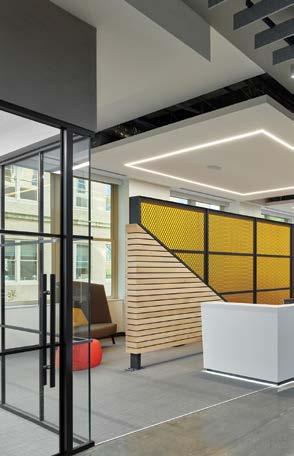
Inspired by the context and local landscape, FIFTEEN designed large-scale graphics that provide community focused messaging in support of the campus-wide themes of respite, retreat, and nature. Created in concert with wayfinding strategies, the colors, textures, and themes organize the building into character zones that help to orient its inhabitants. ■
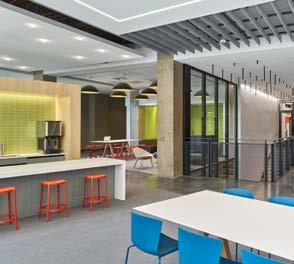
28 SPRING 2023 | context | AIA Philadelphia DESIGN PROFILE
PROJECT: PHMC at 4601 Market Street
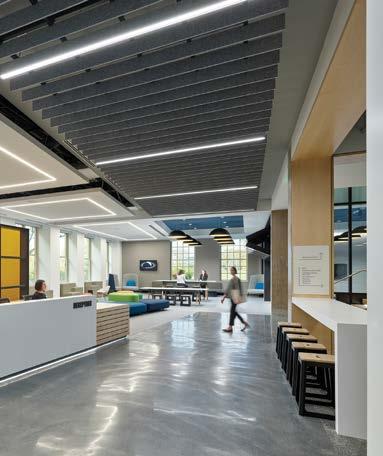

LOCATION: Philadelphia, PA
CLIENT: Public Health Management Corporation
PROJECT SIZE: 19,000 sf
PROJECT TEAM:
FIFTEEN Architecture + Design (Architect)
DEDC (MEP Engineer)
Technology: BALA (Technology)
BEAM Ltd (Lighting)
Bittenbender Construction (Contractor)
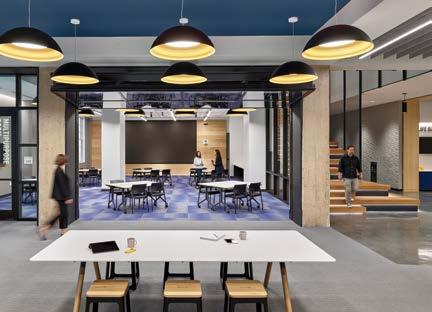
AIA Philadelphia | context | SPRING 2023 29
PHOTOS: JEFFREY TOTARO
DESIGN PROFILE

30 SPRING 2023 | context | AIA Philadelphia
PHOTOS: DON PEARSE PHOTOGRAPHERS, INC.
RALPH J. ROBERTS BOYS AND GIRLS CLUB
Heckendorn Shiles Architects
The longtime Boys and Girls Club of Philadelphia home in Germantown has reopened as the Ralph J. Roberts Club after a $9.3 million renovation and restoration. Built in 1898 as a Boys Club, the four-story Georgian Revival building suffered economic challenges and by the 1930s was already seriously inadequate. An upgrade assessment completed in 1985 found that the rear wing and pool were abandoned and badly deteriorated; the basement regularly flooded; mold and mildew was apparent throughout; and the windows and exterior envelope were in poor condition. Overall, the building failed to meet modern life-safety codes, needed upgrades were not attempted and in the ensuing decades only certain spaces could be used for limited services.
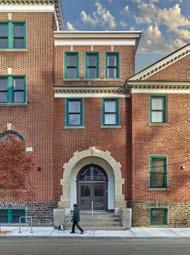
As part of the Club’s Philadelphia-wide “A Bold Change for Kids” $40 million capital campaign, the Germantown building seemed primed for demolition as of 2016 with the Club focusing on constructing a new facility at the
site. Over a three-year span with multiple designs and close community involvement, it was determined that preservation of the iconic structure was the best option to continue the existing urban fabric AND meet program needs.
The renovation and addition to the existing multi-level Club allows for modernized spaces with rejuvenation of the exterior envelope and interior materials. Problem solving for accessibility, streamlined circulation, and associated safety was crucial to address the natural complexity of a split level interior that consisted of seven different levels within a four-story building. Spaces created include a Literacy Center, Learning Center, STEM class, Tech Center, Teen Center, Gym, Music Room, Cafe, and Game Room. The full exterior restoration and interior renovation now evokes the history and the vision of the Club’s mission and will serve 3,000 youth annually with programming afterschool, over the weekend & during the summer. ■
PROJECT: Ralph J. Roberts Boys and Girls Club, Germantown


LOCATION: Philadelphia, PA
CLIENT: Boys and Girls Club of Philadelphia
PROJECT SIZE: 27,000 sf
PROJECT TEAM:
Heckendorn Shiles Architects (Architect)
O’Donnell & Naccarato (Structural Engineers)
Wick Fisher White Engineers (MEP)
Daniel J. Keating Company (General Contractor)
AIA Philadelphia | context | SPRING 2023 31
HARROWGATE DYE WORKS
Ian Smith Design Group LLC
In this adaptive reuse project, the design team focused on:

• Preserving the architectural expression
• Organizing the dimensionality of the space.
• Capturing the embodied energy

Harrowgate is a Philadelphia neighborhood full of abandoned and deteriorating industrial buildings surrounded by traditional row homes. The building was originally built in 1920 for the L.B. Luithlen Dye Works and nearly 100 years later, the building was brought back including the original brickwork detailing. The creation of the “new” trinity design allowed for the cupola to be used as an office/study. The complex contains 39 units and are a combination of industrial and modern styles.
This project represented a significant opportunity to save thousands of kilograms of “carbon dioxide equivalent (CO2e). Tally software was used to document the amount of CO2e that was saved by renovating the structure instead of demolishing it. A comparison of new construction versus preserving the building was compared to international benchmarks. Local artist Alloyius Mcilwaine was brought on to create a vibrant, Philadelphia street-culture inspired mural to enhance the shared community space. The 150-foot wall took 10 days to paint and features vignette portraits of Philadelphia icons in art and music. ■
PROJECT: Harrowgate Dye Works
LOCATION: Philadelphia, PA
CLIENT: Harrowgate Dye Works
PROJECT SIZE: 34,362 sf
PROJECT TEAM:
Ian Smith Design Group LLC (Architect)
Doubleday Design (Civil Engineer)
Menna Engineers & Associates (Structural Engineer)
Denton (MEP Engineer)
Stronghold Development and Construction (General Contractor)
32 SPRING 2023 | context | AIA Philadelphia DESIGN PROFILE
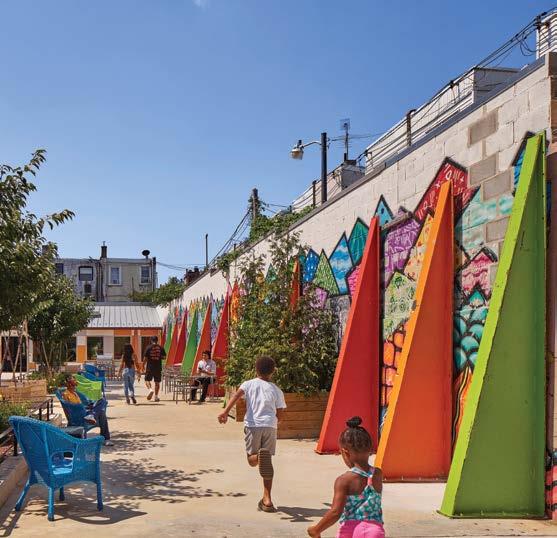
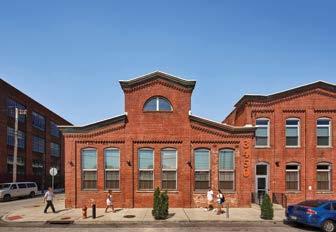
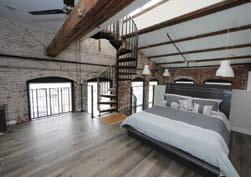
AIA Philadelphia | context | SPRING 2023 33 PHOTOS: COURTESY OF IAN SMITH DESIGN GROUP LLC
DESIGN
AMY GUTMANN HALL
KSS Architects
Lake|Flato and KSS architects have partnered to design a new data science building for Penn Engineering. Amy Gutmann Hall, named in honor of the Penn’s longest-serving president, will be the future home of data science academic and research programs and will centralize resources that will advance the work of scholars across a wide variety of fields, making the tools and concepts of data analysis more accessible to the university community.
Aspirations established during the integrated design workshop focus on creating an environment that connects occupants, who work in a digital world, back to the natural environment. The building will maximize daylight and views, integrate ecological environments into interior spaces, and incorporate sensory stimuli that encourage collaborative social behavior and comfort. To that end, Amy Gutmann Hall will be the first mass timber project for Penn, and the first six-story mass timber building in the city of Philadelphia. The structural system will both reduce the building’s carbon footprint by
52% relative to concrete and 41% relative to steel and create a warm, tactile, and welcoming environment.
The six-story facility will house three floors of teaching labs, active learning classrooms, and collaboration spaces, and three-and-ahalf floors of research centers organized around appropriately scaled neighborhoods that promote flexibility and connectivity. The building will support Penn Engineering’s innovation in data science and engineering (ideas) signature initiative for data science research and community engagement. The ground floor will serve as the home for Penn’s data scientists with a gracious student commons, quiet reading room, small cafe, collaboration spaces, and a large lecture hall. Welcoming researchers from across campus, industry professionals in the private sector, and our Philadelphia community, the building’s dedicated data science hub, located on the third floor, will create a welcoming environment to provide data science support and space for community education and engagement programs. ■

34 SPRING 2023 | context | AIA Philadelphia
PROFILE
PROJECT: Amy Gutmann Hall

LOCATION: Philadelphia
CLIENT: University of Pennsylvania
PROJECT SIZE: 116,000 sf
PROJECT TEAM:
Lake|Flato (Architect)
KSS Architects (Associate Architect)
Ground Control (Landscape Architect)
Pennoni (Civil Engineer)
Burohappold Engineering (Structural Engineer)
Burohappold Engineering ( MEP, FP, Lighting)
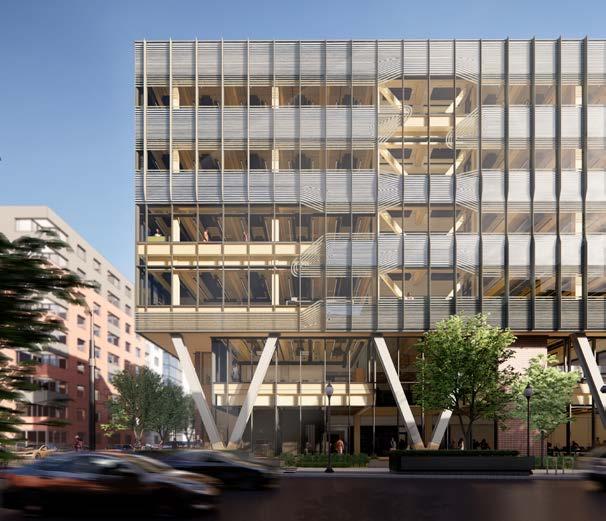
Research Facilities Design (Lab Consultant)
Gilbane Building Company (Construction Manager)
AIA Philadelphia | context | SPRING 2023 35
RENDERINGS COURTESY OF LAKE|FLATO
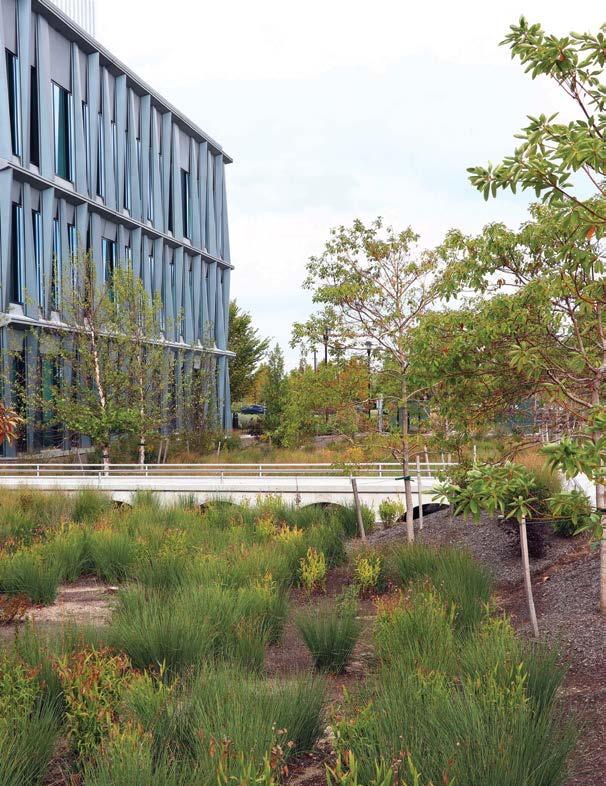
IOVANCE BIOTHERAPEUTICS Ground Reconsidered
Iovance Biotherapeutics, Inc. in the Philadelphia Navy Yard is a LEED Gold biotechnology facility for the production of cancer immunotherapies. The forward-thinking building and site design relate to the innovation happening within the building and greater Navy Yard district. Early in the design process, the decision was made to celebrate stormwater management. To reach the building entry, one must travel across an elevated walkway over the lush bioretention basin, creating daily interaction with green stormwater infrastructure.
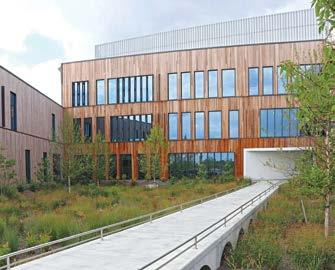
The elevated walkway was created through creative adaptation of modular precast concrete cistern units. The cisterns, designed to be buried below grade, were installed above grade. In profile, the arched structure of the modular units evokes a Roman viaduct. The viaduct is capped with concrete pavement with unique geometric scoring pattern that visually relate
DESIGN PROFILE
PROJECT: Iovance Biotherapeutics
LOCATION: Navy Yard, Philadelphia
CLIENT: Gattuso Development Partners
PROJECT SIZE: 6 acres
PROJECT TEAM:
Ground Reconsidered (Landscape Architect)
DIGSAU (Architect)
Pennoni (Civil Engineer)
Environetics (Structural Engineer)
AKF (MEP Engineer)
GeoStructures (Geotechnical Engineer)
Re:Vision (LEED Consultant)
db|HMS (Building Systems Commissioning)
RWDI (Exterior Enclosure)
The Lighting Practice (Lighting)
Penntex Construction (General Contractor)
Realty Landscaping Corp. (Landscape Contractor)
The Edgewood (Masonry Contractor)
Roma Concrete (Architectural Concrete Paving)

with building façade elements. Low rails provide edge protection along the elevated walkway as well as illumination that is concealed during the day and a dramatic wash of light at night.
The north entry plaza uses a unique mix of bluestone quarried in northeastern Pennsylvania. Flanking the pavers is an artistic arrangement of crushed bluestone of varying sizes, made from by-product waste material, mixed with linear bands of cut bluestone. Retaining the slightly elevated entry plaza are blackened stainless steel retaining walls with integrated lighting. The blackening process results in a living finish that will patina over time. Similar to the north entry plaza, the perimeter of the building is mulched with the crushed bluestone by-product waste material, creating a distinctive look in contrast to surrounding landscapes that use conventional hardwood mulch. ■
AIA Philadelphia | context | SPRING 2023 37
PHOTOS: FRANK GARNIER, GROUND RECONSIDERED
Re:Vision isafullservice sustainabilityconsultingand architecturefirmthatsupportsthe designandownershipcommunities inachievingtheirsustainabilitygoals.
HighPerformanceBuilding Consulting
GreenCertifications(LEED, PassiveHouse,Living BuildingChallenge,WELL, SITES)
ZeroEnergy+ZeroCarbon DesignandBenchmarking BuildingEnclosure
Commissioning
MaterialToxicityVetting
Howcanwesupport yourproject?
revisionarch.com|revisionarch

Global Engineering & Integrated Design Services
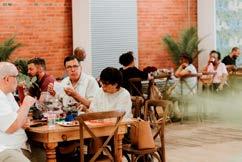
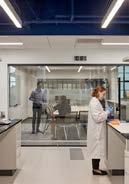
PhotocourtesyofMuhlenbergCollege
Host an Event
Design the perfect event, whether public or private

POWERING HUMAN POTENTIAL for the next generation of discoveries

510 Walnut Street, Suite 1600 Philadelphia, PA 19106
T: 215.735.7290
akfgroup.com
AIA Philadelphia Members Receive a 10% Discount off the Rental Space


AIA Philadelphia Firm Members Receive a 25% Discount off the Rental Space

38 SPRING 2023 | context | AIA Philadelphia
© Robert Benson Photography
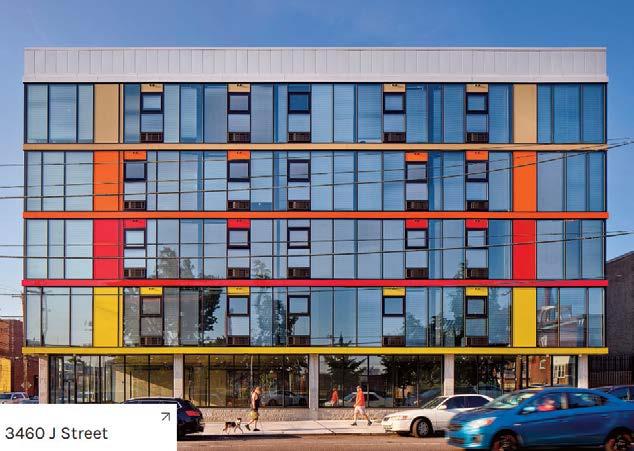





AIA Philadelphia | context | SPRING 2023 39 We want to work with you! Let's make our local neighborhoods a better place to live. The sooner you reach out, the sooner we can start building something, together. To learn more about our services... 215-423-9800 info@strongholdconstructionllc.com www.strongholdconstruction.com
At Stronghold, we understand the importance of stabilizing neighborhoods whose viability is negatively affected by properties that have been foreclosed or abandoned. That's why we focus our work in local neighborhoods.




215-627-0200 wickfisherwhite.com SERVICE • DILIGENT • HUMBLE • FAIR chris@mennaengineering.com O: 267-619-8526 D: 267-619-8527 www.mennaengineering.com 134 Rector Street - Unit 1 Phila. PA 19127 2023 Spring - Menna_Layout 1 2/5/2023 5:37 PM Page 1




LEGAL COUNSEL TO THE DESIGN COMMUNITY RICHARD J. DAVIES, ESQUIRE, HON. AIA. KEVIN J. DMOCHOWSKY, ESQUIRE VITTORIA D. GREENE, ESQUIRE Construction, commercial, and personal injury litigation Contract preparation and review, consultation and risk management Professional and business licensure requirements and compliance Business transactions, dispute resolution, and employment practices BERWYN, PA 610.277.2400 JERSEY CITY, NJ 201.433.0778
MILBERMAKRIS.COM
MILBER MAKRIS PLOUSADIS & SEIDEN, LLP


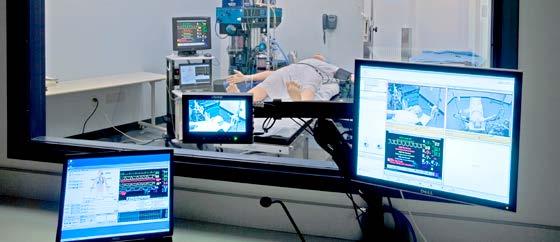

M&T Bank, Radnor, PA BALTIMORE, MD (410) 532-2395 NEW YORK, NY (646) 475-5116 TEMPE, AZ (480) 345-9951 WWW.CTDGINC.COM Villanova University School of Nursing, Villanova, PA Temple University Fox School of Business, Philadelphia, PA









































































































